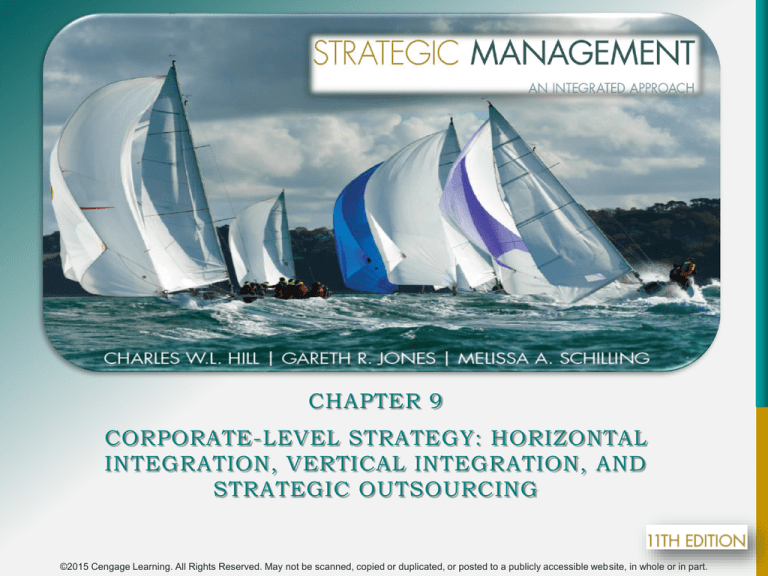
CHAPTER 9
CORPORATE-LEVEL STRATEGY: HORIZONTAL
INTEGRATION, VERTICAL INTEGRATION, AND
STRATEGIC OUTSOURCING
©2015 Cengage Learning. All Rights Reserved. May not be scanned, copied or duplicated, or posted to a publicly accessible website, in whole or in part.
LEARNING OBJECTIVES
Discuss how corporate-level strategy can be used
to strengthen a company’s business model and
business-level strategies
Define horizontal integration and discuss the
primary advantages and disadvantages
associated with this corporate-level strategy
©2015 Cengage Learning. All Rights Reserved. May not be scanned, copied or duplicated, or posted to a publicly accessible website, in whole or in part.
2
LEARNING OBJECTIVES
Explain the difference between a company’s
internal value chain and the industry value chain
Describe why, and under what conditions,
cooperative relationships such as strategic
alliances and outsourcing may become a
substitute for vertical integration
©2015 Cengage Learning. All Rights Reserved. May not be scanned, copied or duplicated, or posted to a publicly accessible website, in whole or in part.
3
CORPORATE-LEVEL STRATEGY
AND THE MULTIBUSINESS MODEL
Corporate-level strategies should be chosen to
promote the success of its business-level
strategies
Which allows it to achieve a sustainable competitive
advantage, leading to higher profitability
©2015 Cengage Learning. All Rights Reserved. May not be scanned, copied or duplicated, or posted to a publicly accessible website, in whole or in part.
4
CORPORATE-LEVEL STRATEGY
AND THE MULTIBUSINESS MODEL
Levels of business model
Business model and strategies for each business unit or
division in every industry in which it competes
Higher-level multibusiness model that justifies its entry
into different businesses and industries
©2015 Cengage Learning. All Rights Reserved. May not be scanned, copied or duplicated, or posted to a publicly accessible website, in whole or in part.
5
HORIZONTAL INTEGRATION
Acquiring or merging with industry competitors
to achieve the competitive advantages that arise
from a large size and scope of operations
Acquisition: Company uses its capital resources
to purchase another company
Merger: Agreement between two companies to
pool their resources and operations and join
together to better compete in a business or
industry
©2015 Cengage Learning. All Rights Reserved. May not be scanned, copied or duplicated, or posted to a publicly accessible website, in whole or in part.
6
BENEFITS OF HORIZONTAL
INTEGRATION
Lowers the cost structure
Increases product differentiation
Leverages a competitive advantage
Reduces rivalry within the industry
Increases bargaining power over suppliers and
buyers
©2015 Cengage Learning. All Rights Reserved. May not be scanned, copied or duplicated, or posted to a publicly accessible website, in whole or in part.
7
PROBLEMS WITH HORIZONTAL
INTEGRATION
Difficult to implement
Conflict with the Federal Trade Commission (FTC)
Increase in prices
Abuse of market power
Crushing potential competitors
©2015 Cengage Learning. All Rights Reserved. May not be scanned, copied or duplicated, or posted to a publicly accessible website, in whole or in part.
8
VERTICAL INTEGRATION
When a company expands its operations either
backward or forward into an industry
Backward vertical integration - Produces inputs for the
company’s products
Forward vertical integration - Uses, distributes, or sells
the company’s products
©2015 Cengage Learning. All Rights Reserved. May not be scanned, copied or duplicated, or posted to a publicly accessible website, in whole or in part.
9
FIGURE 9.1 - STAGES IN THE RAW-MATERIALS-TOCUSTOMER VALUE-ADDED CHAIN
©2015 Cengage Learning. All Rights Reserved. May not be scanned, copied or duplicated, or posted to a publicly accessible website, in whole or in part.
10
FIGURE 9.2 - THE RAW-MATERIALS-TO-CUSTOMER
VALUE-ADDED CHAIN IN THE PC INDUSTRY
©2015 Cengage Learning. All Rights Reserved. May not be scanned, copied or duplicated, or posted to a publicly accessible website, in whole or in part.
11
INCREASING PROFITABILITY THROUGH
VERTICAL INTEGRATION
Vertical integration increases product
differentiation, lowers costs, and reduces
industry competition when it:
Facilitates investments in efficiency-enhancing
specialized assets
Protects product quality
Results in improved scheduling
©2015 Cengage Learning. All Rights Reserved. May not be scanned, copied or duplicated, or posted to a publicly accessible website, in whole or in part.
12
PROBLEMS WITH VERTICAL
INTEGRATION
Increasing cost structure
Disadvantages that arise when technology is
changing fast
Disadvantages that arise when demand is
unpredictable
Vertical disintegration: When a company decides
to exit industries either forward or backward in
the industry value chain to its core industry to
increase profitability
©2015 Cengage Learning. All Rights Reserved. May not be scanned, copied or duplicated, or posted to a publicly accessible website, in whole or in part.
13
COOPERATIVE RELATIONSHIPS
Quasi integration: Use of long-term
relationships, or investment into some of the
activities normally performed by suppliers or
buyers
In place of full ownership of operations that are
backward or forward in the supply chain
©2015 Cengage Learning. All Rights Reserved. May not be scanned, copied or duplicated, or posted to a publicly accessible website, in whole or in part.
14
COMPETITIVE BIDDING AND SHORTTERM CONTRACTS
Competitive bidding strategy - Independent
component suppliers compete to be chosen to
supply a particular component
Short-term contracts - Last for a year or less
Does not result in specialized investments
Signals a company’s lack of long-term commitment to
its suppliers
©2015 Cengage Learning. All Rights Reserved. May not be scanned, copied or duplicated, or posted to a publicly accessible website, in whole or in part.
15
STRATEGIC ALLIANCES AND LONGTERM CONTRACTING
Strategic alliances: Long-term agreements
between two or more companies to jointly
develop new products or processes
Substitute for vertical integration
Avoids bureaucratic costs
Component suppliers benefit because their
business and profitability grow as the companies
they supply grow
©2015 Cengage Learning. All Rights Reserved. May not be scanned, copied or duplicated, or posted to a publicly accessible website, in whole or in part.
16
STRATEGIES TO BUILD LONG-TERM
COOPERATIVE RELATIONSHIPS
Hostage taking: Means of exchanging valuable
resources to guarantee that each partner to an
agreement will keep its side of the bargain
Credible commitment: Believable promise or
pledge to support the development of a longterm relationship between companies
Each company should possess a kind of power to
discipline its partner, if the need arise
©2015 Cengage Learning. All Rights Reserved. May not be scanned, copied or duplicated, or posted to a publicly accessible website, in whole or in part.
17
STRATEGIC OUTSOURCING
Decision to allow one or more of a company’s
value-chain activities to be performed by
independent, specialist companies
Virtual corporation: Companies pursued
extensive strategic outsourcing to the extent that
they only perform the central value creation
functions that lead to competitive advantage
©2015 Cengage Learning. All Rights Reserved. May not be scanned, copied or duplicated, or posted to a publicly accessible website, in whole or in part.
18
FIGURE 9.3 - STRATEGIC OUTSOURCING OF
PRIMARY VALUE CREATION FUNCTIONS
©2015 Cengage Learning. All Rights Reserved. May not be scanned, copied or duplicated, or posted to a publicly accessible website, in whole or in part.
19
BENEFITS OF OUTSOURCING
Lower cost structure
Enhanced differentiation
Focus on the core business
©2015 Cengage Learning. All Rights Reserved. May not be scanned, copied or duplicated, or posted to a publicly accessible website, in whole or in part.
20
RISKS OF OUTSOURCING
Holdup
Risk that a company will become too dependent upon
the specialist provider of an outsourced activity
Increased competition
Building of an industry-wide resource that lowers the
barriers to entry in that industry
Loss of information and forfeited learning
opportunities
©2015 Cengage Learning. All Rights Reserved. May not be scanned, copied or duplicated, or posted to a publicly accessible website, in whole or in part.
21







